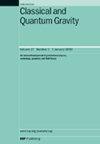遗迹引力子的超高频率尖峰
IF 3.7
3区 物理与天体物理
Q2 ASTRONOMY & ASTROPHYSICS
引用次数: 0
摘要
宇宙引力子的最大频域落在太赫兹区域,在不与现有的现象学边界冲突的情况下,只有少数具有相反(共移动)三动量的粒子产生。因此,产生的物种的光谱能量密度在太赫兹范围内达到峰值,其特征取决于暴胀后的膨胀率。尽管任何对超高频尖峰的可靠检查都应该包括所有低频和中频的延时抑制源,但平均多重度和频谱能量密度的一些相关特性可以在一组简化的近似中推导出来,这些近似可能在频率大大低于Hz时失效。这些并行方法的准确性从过渡矩阵的性质来评估,过渡矩阵将后期谱与暴胀阶段的模态函数的值联系起来。在得到的框架中,迅速推导出了后暴胀膨胀率的界限,并与包含更忠实的数值处理的界限进行了很好的比较。这也意味着,在未来的几年里,如果在兆赫和太赫兹之间工作的机电探测器(如微波腔或波导)最终达到啁啾幅度的灵敏度(至少)比在音频波段(即几赫兹和千赫之间)实验中可以达到的灵敏度小12个数量级,那么后暴胀膨胀率的时间线可能是可以观测到的。本文章由计算机程序翻译,如有差异,请以英文原文为准。
Ultra-high frequency spikes of relic gravitons
The maximal frequency domain of the cosmic gravitons falls in the THz region where, without conflicting with the existing phenomenological bounds, only few particles with opposite (comoving) three-momenta are produced. As a consequence, the spectral energy density of the produced species peaks in the THz range, with features that depend upon the post-inflationary expansion rate. Although any reliable scrutiny of the ultra-high frequency spikes should include all the sources of late-time suppression at lower and intermediate frequencies, some relevant properties of the averaged multiplicities and of the spectral energy density can be derived within a reduced set of approximations that may become invalid as the frequency decreases well below the Hz. The accuracy of these concurrent approaches is assessed from the properties of the transition matrix that relates the late-time spectra to the values of the mode functions during an inflationary stage. In the obtained framework the bounds on the post-inflationary expansion rate are swiftly deduced and compare quite well with the ones including a more faithful numerical treatment. It also follows that the timeline of the post-inflationary expansion rate might be observationally accessible, in the years to come, provided the electromechanical detectors (like microwave cavities or waveguides) operating between the MHz and the THz shall eventually reach sensitivities in the chirp amplitudes which are (at least) twelve orders of magnitude smaller than the ones experimentally attainable in the audio band (i.e. between few Hz and the kHz).
求助全文
通过发布文献求助,成功后即可免费获取论文全文。
去求助
来源期刊

Classical and Quantum Gravity
物理-天文与天体物理
CiteScore
7.00
自引率
8.60%
发文量
301
审稿时长
2-4 weeks
期刊介绍:
Classical and Quantum Gravity is an established journal for physicists, mathematicians and cosmologists in the fields of gravitation and the theory of spacetime. The journal is now the acknowledged world leader in classical relativity and all areas of quantum gravity.
 求助内容:
求助内容: 应助结果提醒方式:
应助结果提醒方式:


